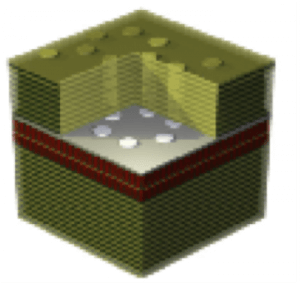Summary
In this project, we build a solid-state quantum simulator for engineering a specific Hamiltonian. Quantum simulators are purpose-built devices with little to no need for error correction, thereby making this type of hardware less demanding than universal quantum computers. Our platform consists of exciton-polariton condensates in multiple quantum-wells sandwiched in a semiconductor Bragg stack onto which a two-dimensional lattice was imprinted. The lattice imprinting can be achieved, for example, by partial etching of the spacer with the lattice pattern followed by an overgrowth of the upper layers of the Bragg structure.
We are particularly interested in exciton-polariton condensates in a kagome lattice, where we can identify topological properties as a function of particle density. A standard optical technique allows us to quantify wavefunctions of exciton-polaritons. To do this, we construct an interferometer for measurement and use power-dependent photoluminescence to identify quantum phases in the kagome lattice.
Our goal is to advance the measurement of topological parameters and knowledge of condensed matter physics in engineered exciton-polariton simulators. This will serve to elucidate quantum phases in a controlled manner and bring us closer to a quantum simulator capable of delivering meaningful insights into quantum materials and optimization.

Figure 1. (top) A hexagonal lattice of micro-cavities formed in a Bragg stack structure with a spacer (white layer) sandwiching multiple quantum wells (red layers). (bottom) Bandstructures of exciton-polaritons in a two-dimensional kagome lattice. As the pump power changes, exciton-polaritons undergo phase transition to form coherent states: below threshold (a) P/Pth ~ 0.04, near threshold (b) P/Pth ~ 1, and above threshold (c) P/Pth ~ 2, where Pth is the threshold pump power.
Related Content

Qubits and Quantum Effects in Biology
It is unknown whether biological processes make direct use of quantum effects, as opposed to depending merely on the influence of quantum physics on chemical bonding and molecular structure.
June 1, 2017

Rydberg Atom Array Quantum Simulator
Summary Quantum simulators enable probing the static and dynamic properties of correlated quantum many-body systems that would otherwise be numerically inaccessible using classical simulators. We are developing quantum simulators based on arrays of neutral atoms excited to Rydberg states. Such Rydberg atom arrays are advantageous for simulating the dynamics of interacting spin systems (Ising spin […]
February 27, 2020

Topological Quantum Computing on Majorana Platform
Full-scale quantum computing will require the capability for error-tolerant quantum information processing.
January 11, 2017
Quantum Sensing Applications using Quantum Communication Technology
Summary The Quantum Encryption and Science Satellite provides a platform to develop and deploy quantum sensing and metrology via photonic channels. This project will build upon ‘free-space’ quantum communication technology and explore new approaches and methods to advance two primary applications: quantum-enhanced telescopes, and spectroscopic sensing for methane detection in the atmosphere. For the […]
December 8, 2018


